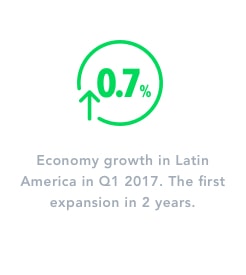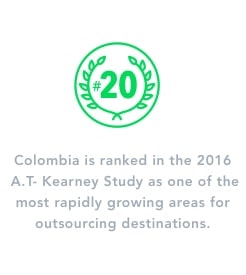Outsourcing Development
Nearshore or Offshore Outsourcing App Development: what’s the best option?
Nearshore outsourcing presents the most viable options considering cost, labor, and geography.

Are you thinking about creating an app? Offshore vs nearshore is the first doubt you will need to solve. The global outsourcing market earned $76.9 billion in revenue, and is expected to grow at a rate of 6.7% from 2015-2025. IT companies, in particular, have demonstrated their interest in outsourcing web and mobile application developers from abroad, along with other tasks. The outsourcing budget for technology companies increased 10.6% in 2016, and they spent $84.5 billion on application outsourcing alone in 2015.
Not only can technology companies save money through app outsourcing, but they also benefit in other, discernible means. In order to maximize the potential of outsourcing, it is important to understand the different options available. Which one offers the services and benefits that most effectively fulfill company goals?
These are the available options for outsourcing:
- Offshore – refers to sourcing devs and other resource needs from a region far away from the place of origin. US companies often outsource to India and Eastern Union in the offshore application development model.
- Nearshore – services
and labor are sent out to a geographical region near to the origin. Still, it’s not within the same borders. In the US case, it would mean outsourcing to Latin American countries. - Onshore – describes the strategy of assigning roles and services to a company located within the same geographic borders.
Offshore vs Nearshore Outsourcing – What’s the best model for me?
If you are looking for iterative and Agile development strategies; cooperative development procedures; fast and easy communication; rapid prototyping; and user-centric design, nearshore is the option for you. For these reasons and other essential factors, nearshore is the best option for outsourcing. We’ve laid out the three major reasons for why this is the case, and how your company can benefit from pursuing a nearshore outsourcing model.
If you want to know more about it, take a look at our webinar “Tips to maximize outcomes from outsourcing”. You will learn how to prepare your company for an outsourcing strategy. UruIT has worked with nearshore outsourcing for over a decade and our clients believe this is a great option to boost results and reduce risks.
3 Major Reasons Why U.S. companies choose Nearshore Outsourcing
#1. Cost-Efficiency

For a process like outsourcing web and mobile application development and design, reducing costs is often the priority. In fact, a Deloitte survey revealed that 59% of businesses that outsource did so for cost-cutting purposes. In the IT sector, this number jumped to 87%.
Utilizing a nearshore outsourcing option for mobile and web development is cost-effective. Meaning this method provides advantages in both the initial cost standpoint, and in its risk-averseness. There are a few factors to watch out for that contribute to the cost of delivery, as enumerated in a recent Everest Group study:
- Scalability
- Language skills and proficiency
- Tech skills
- Types of services
- Complexity of work
- Geography served
- Talent offering
- Choice of location

By hiring a foreign development team in a nation not too far from home, you can still reap the benefits of lower costs regarding all of the above when compared to sourcing onshore within the U.S.
Additionally, nearshore outsourcing avoids the quality concerns associated with offshore apps development. Nearshoring outsourcing in Latin America is especially attractive for US companies seeking cheap outsourcing options. With financial attractiveness being the most important feature of outsourcing factors, a 2016 A.T. Kearney Study ranked six Latin American countries among the top 20 in fulfilling these aspects.
Evaluating the best investment
If we compare, onshore outsourcing is the most expensive outsourcing option. Though it is still cheaper than internal hiring, native restrictions, wages, and other factors remain to run up costs. In the U.S., where even the minimum wage (which is often lower than what an IT professional–even an outsourced one–charges) exceeds the rate of offshore or nearshore talent. Therefore, onshore outsourcing can be a costly endeavor.
Offshore software development, though cheaper than onshore by 40-55%, often includes hidden costs that arise from doing business in such a faraway nation. As demonstrated in the Everest Group study, the complexity of the work in terms of it being judgemental vs transactional, the quality of skill required (generic vs niche), and experience level (entry vs experienced) can contribute to higher costs.
Whenever an issue arises with an offshore app development partner, the costs of handling it can add up to the point of offsetting the funds saved at first. Geography served and choice of location are the Everest Group delivery cost factors to be wary of. And keep in mind: When outsourcing app development, problems are likely to arise. It’s the nature of conducting business externally; hence the importance of constant communication. Problem-solving becomes more difficult (and costly) when there is a language, time, and/or culture barrier.
#2. Skilled Labor

In some cases, there aren’t even enough qualified, internal employees to cull from. In IT, this is especially true: A study of HR managers revealed that 86% of them have difficulty hiring for technology-related positions in companies. Additionally, technology businesses require a level of skill and experience that is unprecedented in other industries. Concerns over H-1B visa
Nearshore outsourcing can provide the skilled, foreign web development team a company requires. And it is at the same level of onshore labor but at a fraction of the cost. Latin American nearshore outsourcing, in particular, has the resources and development necessary to cull a team of experienced developers.

This information was recently published by Focus Economics. A major reason for this development was the greater emphasis on technology and the benefits of free trade provided by NAFTA and CAFTA. $31.5 million in venture capital was distributed among 1,333 startups in the region in 2016, and major investment companies like HCL, Infosys, and Wipro were in the area as of 2015. Furthermore, the Internet penetration rate reached 61% in 2015 (far ahead of the global average of 45%).
Top-notch talent
All of these internal conditions allow for the domestic labor force of Latin America to increase their skill level by making the technical resources more readily available. With economic development comes greater access to the tools, education, and experience software developers need to become more adept. As a result, Latin American is an appealing option for hiring skilled app coders that are becoming increasingly capable due to domestic conditions.
Onshore outsourcing presents an option for hiring labor within borders, which often ensures a high level of quality. However, this method is only recommended for companies with enough funds to allot to outsourcing, as it is also the most expensive. Additionally, onshore outsourcing doesn’t necessarily mean avoiding the same pitfalls as other outsourcing options. Because the labor force is still working remotely, so communication is challenging anyway.
For 28% of businesses that rely on outsourcing for core business functions, offshore app development is probably not the right choice. Ensuring a high standard of education and experience is difficult when working with a company so far away. Besides, other barriers, from language to cultural, result in a deficiency of reliable, skilled workers.
#3. Geography and Its Implications

The role geography plays in outsourcing is often overlooked for the cost benefits. However, how near or far a region
Nearshore outsourcing addresses all three implications of geography in the outsourcing procedure. To begin with, most of Latin America is on the same or very similar time zone as the United States. Being in the same time zone allows communications to occur on the same schedule. As a consequence, it encourages greater cooperation throughout the development process.

Cultural and language similarities are key for ensuring standards. Therefore, both ends understand the goals and communicate well. Language and cultural barriers can cause frustration and higher fees (e.g. miscommunication about costs), so it pays (literally) to outsource development to Latin America.
More info in the EF English Proficiency Index.
Culture & other limitations
For iterative and innovative software development, traveling is a crucial part of the quality assurance process and product development. The costs of traveling to and from the U.S. to Latin America vs India or China are very different. From New York City to Mumbai, the average price is over $800 and average flight time is approximately 15 hours (nonstop). Traveling to Colombia, meanwhile, is on average a three-hour flight and costs only $250.
Offshore app development presents the greatest risks when it comes to geographic consequences. Countries are often far away, with extremely different languages and cultures. As a result, companies that go the route of offshoring often experience miscommunication that leads to slower turnaround. Other problems that come out are low productivity and an overall unpleasant experience. Building innovative apps requires an understanding of the native users’ culture. Nearshore outsourcing to Latin America accomplishes this task because the U.S. and Latin America share similar media, consumption habits, and even history. Thus, it is easier to understand the more nuanced aspects of an American app user’s behavior when developing the product.
Nearshore outsourcing presents the most viable options considering cost, labor, and geography.
These are the most important aspects to any business pursuing this method. By keeping prices low, having a similar language and culture to the U.S. to prevent miscommunications. Also, having a developing economy spurring the growth of a skilled labor sector, Latin America provides everything an outsourcing IT company should be looking for.
-

 Marketing Tips1 day ago
Marketing Tips1 day agoWhat is my Instagram URL? How to Find & Copy Address [Guide on Desktop or Mobile]
-

 Business Imprint3 days ago
Business Imprint3 days agoAbout Apple Employee and Friends&Family Discount in 2024
-

 App Development3 days ago
App Development3 days agoHow to Unlist your Phone Number from GetContact
-

 News4 days ago
News4 days agoOpen-Source GPT-3/4 LLM Alternatives to Try in 2024
-

 Crawling and Scraping4 days ago
Crawling and Scraping4 days agoComparison of Open Source Web Crawlers for Data Mining and Web Scraping: Pros&Cons
-

 Grow Your Business1 day ago
Grow Your Business1 day agoBest Instagram-like Apps and their Features
-

 Grow Your Business4 days ago
Grow Your Business4 days agoHow to Become a Prompt Engineer in 2024
-
Marketing Tips1 day ago
B2B Instagram Statistics in 2024





